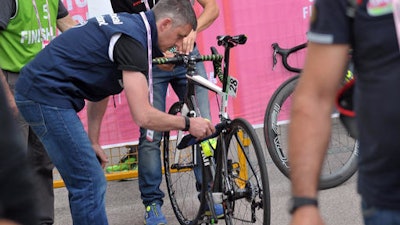
There is perhaps no Olympic sport as dependent on technology as cycling, where space-age, feather-light carbon fiber bikes can cost more than a car and make the difference between a gold medal and nothing.
That has also made the sport ripe for an entirely new kind of doping: mechanical.
Rumors have flown for years that riders were finding ways to hide tiny electrical motors in their frames, or using magnets in their wheels, to produce a couple extra watts of power. But it wasn't until a young cyclocross racer was discovered to have a motor hidden in her bike frame last year that it became the issue de jour.
Now, mechanical doping is every bit as controversial as biological doping.
"I think when these rumors first started to surface, most normal people that it was fantastical, and nobody would stoop so low to cheat this way," said Brian Cookson, president of the UCI, cycling's world governing body.
"But soon it became obvious the technology was available. It was out there," he said. "We've seen allegations of fraud, and clearly this form of cheating is a possibility and we're taking it very seriously."
That's a marked change from the past, when former UCI president Pat McQuaid said as recently as 2010 that using hidden motors in bikes was "not practical" because a battery would need to be the size of a "bag of sugar."
Well, batteries these days are no bigger than a thumbnail. Motors are just as small. And that has forced the UCI to develop tests to detect them in major races, including the Rio Olympics.
The UCI will work hand-in-hand with the International Olympic Committee to test bikes this August, both using proprietary software that the governing body developed for iPads. The system essentially scans a bike for magnetic fields that could indicate the presence of motors, and is advanced enough to distinguish between illegal technology and the electronic shifting systems that have become common among elite riders.
The UCI began scanning bikes in January and has already examined several thousand, including every bike at the Giro d'Italia. UCI technical manager Mark Barfield anticipates 12,000 tests by the end of the year.
Still, some do not believe the system is fail-proof. Video has circulated from European races believed to show heat signatures within bikes that could be consistent with the presence of hidden motors.
The UCI countered that thermal imaging, X-rays and ultrasonic devices have been deemed ineffective.
"We think we have a very effective defense against this," Cookson said in an interview with The Associated Press. "We've all heard the rumors and seen the allegations and videos, but at the end of the day, our method is the only method that has actually caught somebody."
USA Cycling has partnered with FLIR Systems, a thermal imaging manufacturer , to monitor bikes at its events. Cameras are set up at critical points of races, including the national championships in May, and they record images that can later be examined by USA Cycling officials.
"These cameras not only allow you to see in total darkness, adverse weather, haze and smoke," said FLIR Systems vice president Travis Merrill, "but they can detect unnatural heat sources like those used in mechanical doping."
Last April, the UCI set down rules for what Cookson prefers to call "technological fraud." They include a minimum six-month ban and a fine of up to 200,000 Swiss francs ($206,000). Offending teams face disqualification, a suspension and fines of up to 1 million Swiss francs ($1,035,000).
"Your entire career is not only finished, everything you've achieved up until then is brought into question," Cookson said. "I don't know why that's a risk you would want to take."
Indeed, there is little to lose for riders competing in amateur races or small professional events. But when the stakes are hundreds of thousands of dollars in WorldTour races, or a life-changing gold medal from the Olympics, the temptation becomes a little harder to ignore.
"Just like biological doping, it's something we have to be watchful of," USA Cycling chief executive Derek Bouchard-Hall said. "The idea is to create a level where you keep honest people honest."
While the UCI is confident its current testing system is effective, the challenge now — not unlike biological doping — is staying ahead of the curve. New technology is being developed all the time, the batteries and motors are becoming so small that eventually they may be invisible to the naked eye.
The sport of cycling has only recently begun to move beyond its drug-tainted past. Will a new form of cheating drag it through the mud once more?
"It never even crossed my mind when I was participating," Bouchard-Hall said. "It's a phenomenon in the last five years. But yes, it's something we have to be concerned about."






















